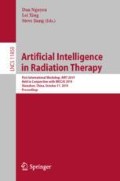Abstract
Current radiotherapy planning workflows start with segmentation of the organs at risk (OARs) together with target volumes (TVs) in order to determine a patient specific optimal treatment plan and its corresponding 3D dose distribution. This is a time-consuming optimization process including many manual interventions. Despite strong resemblance between patients treated for the same indication, the optimization is almost always performed without 3D prior knowledge. Automated segmentation of OARs and TVs and automated generation of dose distributions are thus expected to be more time-efficient. We investigate the feasibility of CT-only dose prediction and the profitability of additional isocenter and contour information. To evaluate the network’s performance, a 5-fold cross-validation is performed on 79 prostate patients, all treated with volumetric modulated arc therapy.
Access this chapter
Tax calculation will be finalised at checkout
Purchases are for personal use only
References
Craft, D.L., et al.: Improved planning time and plan quality through multicriteria optimization for intensity-modulated radio-therapy. Int. J. Radiat. Oncol. Biol. Phys. 82(1), 83–90 (2012)
Otto, K., et al.: Volumetric modulated arc therapy: IMRT in a single gantry arc. Med. Phys. 35(1), 310–317 (2007)
Nijkamp, J., et al.: Adaptive radiotherapy for prostate cancer using kilovoltage cone-beam computed tomography: first clinical results. Int. J. Radiat. Oncol. Biol. Phys. 70(1), 75–82 (2008)
Yan, D., et al.: Adaptive radiation therapy. Phys. Med. Biol. 42(1), 123–132 (1997)
Yand, H., et al.: Replanning during intensity modulated radiation therapy improved quality of life in patients with nasopharyngeal carcinoma. Int. J. Radiat. Oncol. Biol. Phys. 85(1), 47–54 (2013)
Oelfke, U., et al.: Intensity modulation, inverse planning, proton-therapy, radiation therapy. Med. Dosim. 26(2), 113–124 (2001)
Nelms, B., et al.: Variation in external beam treatment plan quality: an inter-institutional study of planners and planning systems. Pract. Radiat. Oncol. 2(4), 296–305 (2012)
Ibragimov, B., et al.: Segmentation of organs-at-risks in head and neck CT images using convolutional neural networks. Med. Phys. 44(2), 547–557 (2017)
Van der Veen, J., Willems, S., et al.: Benefits of deep learning for delineation of organs at risk in head and neck cancer. Radiother. Oncol. 138, 68–74 (2019)
Nguyen, D., et al.: Dose prediction with U-net: a feasibility study for predicting dose distributions from contours using deep learning on prostate IMRT patients. Arxiv (2017)
Nguyen, D., et al.: Three-dimensional radiotherapy dose prediction on head and neck cancer patients with a hierarchically densely connected U-net deep learning architecture. Arxiv (2018)
Fan, J., et al.: Automatic treatment planning based on 3D dose distribution predicted from deep learning technique. Med. Phys. 46(1), 370–381 (2018)
Kearney, V., et al.: A volumetric dose prediction algorithm using 3D fully- convolutional neural networks. Phys. Med. Biol. 63(23), 61–78 (2018)
Lips, I.M., et al.: Single blind randomized phase III trial to investigate the benefit of a focal lesion ablative microboost in prostate cancer (FLAME-trial): study protocol for a randomized controlled trial (2011)
Ronneberger, O., Fischer, P., Brox, T.: U-Net: convolutional networks for biomedical image segmentation. In: Navab, N., Hornegger, J., Wells, W.M., Frangi, A.F. (eds.) MICCAI 2015. LNCS, vol. 9351, pp. 234–241. Springer, Cham (2015). https://doi.org/10.1007/978-3-319-24574-4_28
Author information
Authors and Affiliations
Corresponding author
Editor information
Editors and Affiliations
Rights and permissions
Copyright information
© 2019 Springer Nature Switzerland AG
About this paper
Cite this paper
Willems, S., Crijns, W., Sterpin, E., Haustermans, K., Maes, F. (2019). Feasibility of CT-Only 3D Dose Prediction for VMAT Prostate Plans Using Deep Learning. In: Nguyen, D., Xing, L., Jiang, S. (eds) Artificial Intelligence in Radiation Therapy. AIRT 2019. Lecture Notes in Computer Science(), vol 11850. Springer, Cham. https://doi.org/10.1007/978-3-030-32486-5_2
Download citation
DOI: https://doi.org/10.1007/978-3-030-32486-5_2
Published:
Publisher Name: Springer, Cham
Print ISBN: 978-3-030-32485-8
Online ISBN: 978-3-030-32486-5
eBook Packages: Computer ScienceComputer Science (R0)


